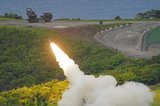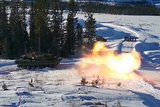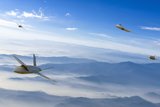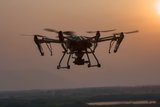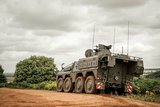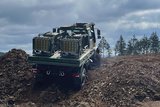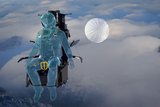Soldiers See – And Touch – Full-Scale LTAMDS (sponsored)
This article is brought to you by Raytheon Technologies.
The Lower Tier Air and Missile Defense Sensor, commonly called LTAMDS, is a radar designed to defeat advanced and next-generation threats including hypersonic weapons, or those that fly faster than a mile a second.
It’s one thing to hear a project is going well. But it’s much better to see it for yourself – and to have a chance to make it even better.
That was the thinking behind the “Soldier Touchpoint,” a September meeting of a group of Army soldiers and the Raytheon Missiles & Defense team that is building the Lower Tier Air and Missile Defense Sensor, called LTAMDS, a next-generation radar designed to defeat newer threats such as hypersonic weapons.
The system is on time and on track.
“The recent delivery of the first full-scale LTAMDS to the test site signifies LTAMDS is hitting all the marks,” Raytheon Missiles & Defense's U.S. Requirements and Capabilities Director Bob Kelley said. “The actual radar is sensing, in less than a year from contract award.”
The Soldier Touchpoint event not only gave the Army team a chance to see the radar up close, it also enabled them to give crucial early feedback to inform potential improvements.
“Providing the warfighter’s early input during the design phase of the system gives Raytheon Missiles & Defense an unparalleled ability to deliver the right capability, at the right time, to the U.S. Army,” said Eric Maule, a manager in U.S. Requirements and Capabilities with Raytheon Missiles & Defense. Maule participated alongside the U.S. government during this event.
The mere sight of the radar kick started discussions on all kinds of topics like tactical deployment, march order and emplacement and the replacement and removal of parts.
A similar process informed the design and production of another Raytheon Missiles & Defense product called the Warfighter Machine Interface, or WMI, a user-friendly control system for the Patriot air and missile defense system. Soldiers provide feedback to the designers and engineers to ensure the system meets user expectations.
The Army arrived in force with a diverse team of soldiers, including personnel from the Air and Missile Defense test detachment, Army Capability, Army Futures Command, and the Program Executive Office Missiles and Space. “This team was eager to roll up their sleeves and help clarify user concepts of operations and employment requirements,” Maule said.
Raytheon Missiles & Defense built the radar prototype for the U.S. Army's "Sense Off" competition and recently delivered the first full-scale LTAMDS to the test site in record time.
Soldiers collaborate with LTAMDS team
This teaming up highlights LTAMDS cooperation with the Army. What the LTAMDS team does on the new sensor is done collectively with the Army.
“This and subsequent Soldier Touchpoint events provide Raytheon Missiles & Defense with an unprecedented opportunity for user involvement”, said Justin Weissert, P3I sustainment technical lead for Raytheon Missiles & Defense. Weissert was a key organizer for the soldier Touchpoint event.
“The LTAMDS team thinks in terms of ‘we’ as in ‘we are in it together’ and ‘we’re doing it with the Army’,” Kelley said. “It is a complete collaboration.” For example, the Army embeds in the LTAMDS technical and production teams. This way they join program meetings and actively engage if and when any challenges may come.
The challenge of getting together amid COVID-19
Getting LTAMDS to the test site was a team effort in itself. The COVID-19 pandemic added challenges but did not deter the team.
Master Sergeant Derrick Lee, a former first sergeant and now Operations and Capability Development noncommissioned officer at the Air and Missile Defense cross-functional team, knows all too well the behind-the-scenes complexity of getting the right people to the right place at the right time.
“I am amazed at how the team was able to conduct a premier presentation in a premiere location, all while maintaining full COVID compliance,” Lee said.
“It’s a true testament to this team, their unwavering commitment to the program, and their ability to adapt to any circumstance,” said Bill Patterson, the LTAMDS program area director with Raytheon Missiles & Defense. “Without a doubt, they are up to the challenge.”
Where the journey began
The U.S. Army sought a next-generation radar to help defeat increasingly complex and technologically advanced threats, like hypersonic weapons, or those that fly faster than a mile a second. Raytheon Missiles & Defense, one of four business of Raytheon Technologies, answered the call with the revolutionary LTAMDS.
And how quickly it has evolved. The Army selected Raytheon Missiles & Defense to provide its next-generation radar in October 2019. Raytheon Missiles & Defense built the first radar antenna array less than 120 days after the award.
The LTAMDS is a 360-degree radar that uses active electronically scanned array, or AESA, and gallium nitride, a circuit material that strengthens the radar signal and enhances its sensitivity. for longer range, higher resolution and more capacity. The radar provides greater capability against proliferating and more stressful threats. The company has made significant investments over the past two decades in AESA technology, gallium nitride technology and advanced manufacturing.
The result: a radar with no blind spots. Other benefits include improved sensor performance and reliability.
Click here to learn more about LTAMDS.
More from Industry Spotlights
-
![The future is here: Sixth-gen air dominance]()
The future is here: Sixth-gen air dominance
How RTX is equipping the military airspace – for today’s fleet and tomorrow’s fight.
-
![De-Risking the Future: Manufacturing Certainty for Unmanned Systems]()
De-Risking the Future: Manufacturing Certainty for Unmanned Systems
How strategic manufacturing partnership solves the industrialisation triad — Scale, Compliance and Cost — for hyper-growth defence tech innovators.
-
![Battlefield mobility, made in the UK]()
Battlefield mobility, made in the UK
How does Britain ensure that we can preserve the lives of our soldiers and allies – now and in the future – with homegrown innovation and resilient domestic manufacturing? At Pearson Engineering, we are proud to be a central part of the answer to this increasingly important question.
-
![Strengthening Baltic defence capabilities]()
Strengthening Baltic defence capabilities
How Latvia is bolstering its territorial defences, industrial capacity and international cooperation with Dynamit Nobel Defence’s SKORPION2 Remote Mining System.
-
![Barco’s vision to trust: from past to future]()
Barco’s vision to trust: from past to future
Barco’s story is one of constant evolution enabling more immersive, reliable, and future-ready training experiences.
-
![How are next-generation ejection seats helping pilots when they need it most?]()
How are next-generation ejection seats helping pilots when they need it most?
The ACES 5 ejection seat from RTX’s Collins Aerospace introduces new, innovative and patented technologies to help save lives.










